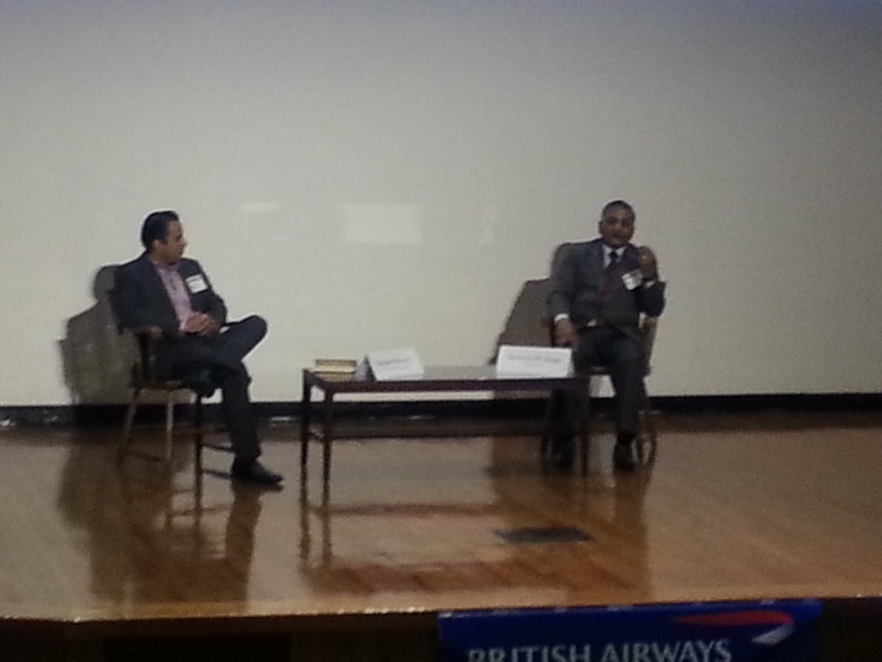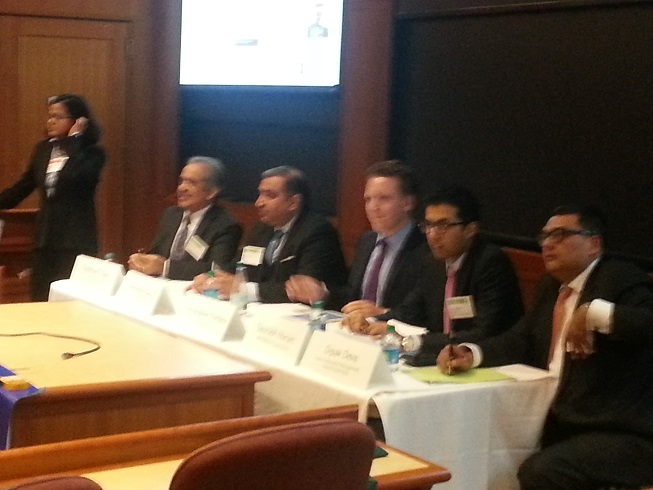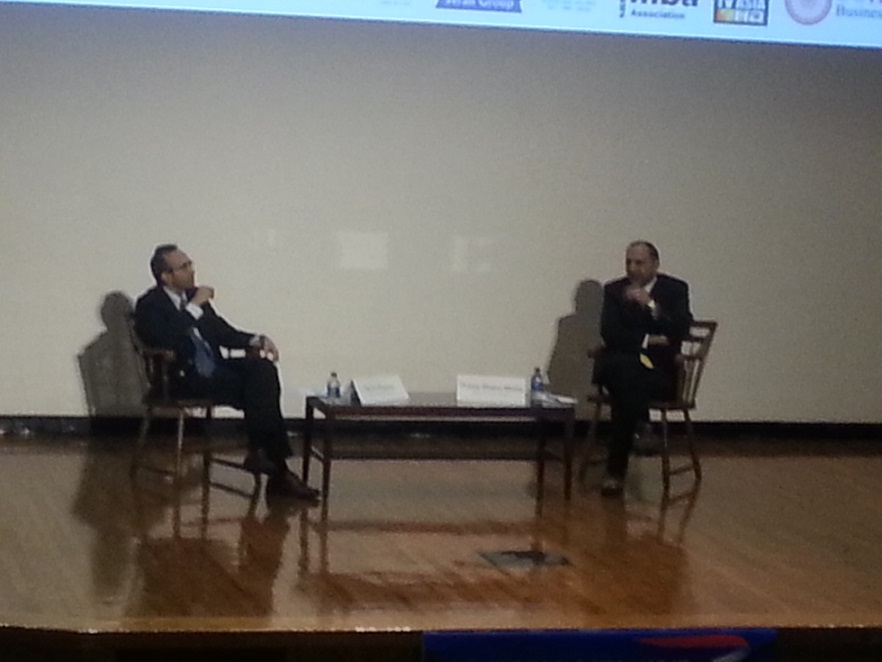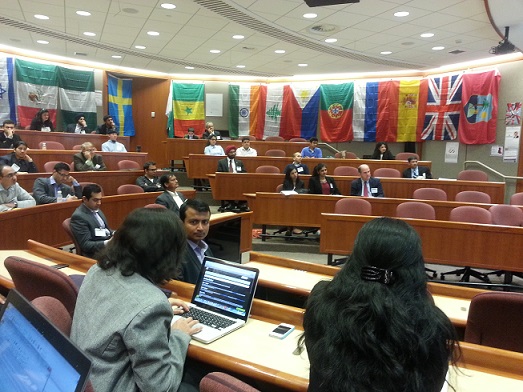Contribute
| Harvard India Conference - Day 1 |
Vijay Basra
02/26/2014
(This article is sponsored by Masala Art)
The Harvard India Conference, one of the largest of its kind, was held at the Harvard Business School and Harvard Kennedy School on February 15-16, 2014. The organizing team consisted of Vivekdeep Gupta, Sanya Gurnami, Smriti Jyaraman, Mohit Rajani, Kim Fernandes, Rashmi Pillai, Rasika Sridhar Sethi and Divya Verma. The conference featured 8 keynotes and 22 panels focusing on leadership, business, education, manufacturing, technology, entertainment, travel, and other industries.
Part 1 provides a summary of three events from Day 1 focusing on:
Leadership Lessons from the Indian Army Keynote speaker General V K Singh, Former Chief of the Indian Army
Manufacturing in India: Shifting gears into the next growth phase, and
Is India the Gateway for the Post PC Devices in Emerging Markets
General V K Singh, Former Chief of the Indian Army
The General explained that the Indian Army is very diverse in its constituency with people of many religions, language and cultural background. The Indian Army still runs on the old British regimental model which consist of small group. These group are like families and the General advocated that this model continues to server the Indian Army very well. The modern Indian Army’s experience rests on its participation in World War II and it is currently the second largest army in the world. Its success is built on what the General called trust between officers and their subordinates. Personal interest is subordinate to national interest is the core ethic of the Indian Army.
When asked by Professor Tarun Khanna of the Harvard Business School what business and others could learn about leadership form the Army, the General responded with the key attributes that he labeled as the 5 C’s as the core value of the Indian that he believed separates the Army from other organizations. In his definition leadership constitutes the 5 C’s of character, courage, conviction, confidence and care. Ethical conduct in his eyes was the number one quality to have and character the most important of the C’s. Character is the most important is it comprises many of the other elements with proper proportion and balance.
In his view a leader must be able to visualize what is needed and manage the change that is needed. Leaders rely on intuition and gut feel which is only arrived at over years of experience. The second aspect of leadership is focus and resolve. He must shape the ways and means and find a path. When asked about the key differences between business and the military, the General to his credit was very clear and forthcoming. Military situations are simpler and in the military there is absolutely no option to loose. Many in business can be successful even if the business loses and is unprofitable.
Regarding what is happening in politics in India today, he spoke of major winds of change resulting from the improved living standard but driven by the desire for better governance, less corruption and opportunities for further betterment. The current political system has made many rulers rather than representatives of the electorate. The hardest change is to change the system of governance. He is has never been as optimistic as he is now with the upcoming elections.
The interview was very motivational. Though the conference primary caters to business, academics and student of business and government, any parent from the Indian American community would have treasured the value of this talk kind for their children.
The panel participants were Mr. Amit Kalyani, Executive Director of Bharat Forge, Mr. Shishir Joshipura, Managing Director and Country Head of SFK India and Mr. Pradeep Bhargava, Director for Cummins India. The moderator for this panel was Prof. Yaheng Huan, Associate Dean and Professor of International Management at the Sloan School of Management, MIT.
Prof. Huan provided some background to manufacturing growth in India and its relationship with other parts of the world prior to discussion. The standard sequence for most countries in world has been to transition from agriculture to industry to manufacturing and then services. India is unique that it transitioned from agriculture to industry to services. Other key factors about India are: 85% of exports come from the services segment of the economy. Regarding pharmaceuticals, 150 drug have been certified in India and only 5 in China. India lags in broad manufacturing except in part for auto industry and pharmaceuticals. Though India invented Sepecial Economic Zones in the early 60’s but they only really took off in China.
All the panel participants were from Poona and from the mechanical manufacturing industry. Poona is a manufacturing Hub for India. Mr. Joshpura started of the discussion remarking that there is too little spent on R&D. India has received many Demmings Awards so there is quality but that is not seen as such by the outside world.
Mr. Bhargava of Cummins previously worked for GE, Sharp and other multinational corporations. Labor is more concerned with health and sanitation than with equity stakes in the company. Green manufacturing in India goes beyond compliance. The main problem is converting India’s potential energy into kinetic energy. Lack of trust, ambiance and confidence are major hindrances. Mr. Bhargava emphasized the need for channel partners and diversity in supply for manufacturing.
For Mr. Kalyani infrastructure, talent and policy are the issues in manufacturing for India. Success of the Poona industrial cluster is a result of proximity to a port, legal and political long term support from the state government and a third generation industrial work force. Poona had a progressive government in the 70 and 80 with many engineering schools. Mr. Kalyani reported that companies have started their own technical colleges including Bharat Forge which is going after fresh talent from village schools and not restricting themselves to the cities. There is a shortage of technical talent, managerial talent and leadership talent. Bharat Forge has stated a joint program with the likes of the University of Warwick of the UK.
All agreed the manufacture cannot simply compete on cost. Problems in manufacturing are in process issues, operating in a culture where the tendency of workers is to take short cuts, high cost of infrastructure, and 17 levels of taxation. Manufacturing executives in India are thinking hard on how to generate growth that is not dependent of policy. But how do you do that? For Mr. Joshpori manufacturing needs to be highly differentiated, knowledge based, and deliver a global solution. He feels he is doing this through R&D. But is that really manufacturing? Despite these issues there continues to a significant and increasing presence of international companies in the Poona area.
The panelists consisted of Mr. Sashin Devsare, Director of Karbonn Mobiles which is part of the Jainal Group, Mr. Mohinder Jain, Managing Director and Vice President of Logitech, and Mr. Ravi Swaminath of AMD India. This session was moderated by Prof. Shikar Ghosh of the Harvard Business School.
This session was about the future of PC’s and Smart phones. Only the Smart phone has grown in India. Smart phone content creation is the next big step . Mr. Devsavre told us that Karbonn Mobile is the third largest cell phone brand in India. India is an 80% prepaid market. Bandwidth is a limiter. 2G is everywhere, 3 G in 100 cities and 4G in only 4 select cities. Karbonn is investigating market for their 2G phones in the Ukraine. Growth is in appliances and services. YouTube and Facebook, E-commerce, and bus tickets are major growth areas for the Smart phone. Future new markets include voice enabled data seen as an application for rickshaw drivers.
The term PC’s here covers PC’s, laptops and tablets including value added attachments. Mr. Swaminath talked of the inverted pyramid, the golden age of PC’s is yet to come. We should think of PC’s as an eco-system that serves many segments. China’s shipments of PC’s is 3 to 5 times that of India. Logitech is a manufacturer and supplier of computer mice, webcams and peripherals. For Mr. Jain the future of PC is in the downgraded PC, namely the PC minus. According to Mr. Jain, India has not even started to build PC minuses.
Is there tension between these two product classes? Neither product groups are cannibalistic on the other. In the end it was resolved that there was no tension. If any it was in manufacturing where decision needed made to which of the two should get higher investment. Everybody agreed that India is punching far below their weight in this arena. India’s strengths are for developers for the likes of Play Store. For the time being China appears to be the Gateway.
You may also access this article through our web-site http://www.lokvani.com/




